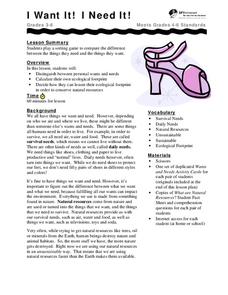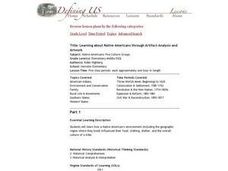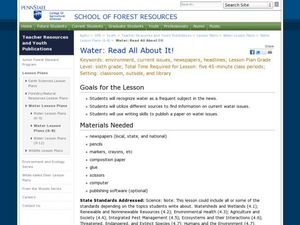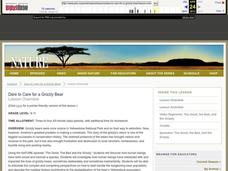Curated OER
Miss Rumphius
Students engage in a literature study in order to appreciate the world around them and create an innate instinct of working for the cause of conservation for the environment. They answer guided questions that use the story as a resource.
Curated OER
The Hudson's Ups and Downs
Even rivers have tides. Older elementary schoolers will discuss the Hudson River and how weather, water craft, and the ocean cause tidal fluctuation. They will examine a series of line graphs that depict tidal fluctuation, then analyze...
City and County of San Francisco
I Want It! I Need It!
Discuss wants and needs with your elementary ecologists and get them to consider what would happen to our natural resources if we all got everything that we want. Learners play a card sorting game and take an ecological footprint quiz on...
Curated OER
"Habitats"
Students complete a unit of lessons on animals and animal conservation. They observe a square meter of ground outside the school, set up a model environment, analyze an owl pellet, grow bread mold, and explore various websites.
Curated OER
John Muir in Yosemite
Learners explore different ways to value the environment and participate in a simulation of a historical debate to protect Yosemite as a National Park. They are assigned various roles in the debate in which they must research and present...
Curated OER
TE Lesson: Energy Transfer in Musical Instruments
Learners study concepts of energy and energy transfer. They look at how these concepts apply to musical instruments. They study the law of conservation of energy. They use the concepts studied in the lesson plan to design a musical...
Curated OER
Learning about Native Americans through Artifact Analysis and Artwork
Sixth graders assess how a Native American's environment and the geographic region where they lived influenced their food, clothing, shelter and the overall culture of a tribe. They study the impact of conservation, family, rural life,...
Curated OER
Recycling
Young scholars relate recycling to waste reduction. In this science lesson, students talk about the environment and how recycling certain natural resources actually saves on energy. They also discuss what type of recycling causes...
Curated OER
Pollution Prevention in Schools
Students review P2 concepts they learned in previous lessons and explore how to reduce the pollution in their school. They also examine ways to conserve energy.
Curated OER
Light, Sound and Energy
The students will be given opportunities to work independently and in teacher-directed situations to study and discover the many facets of light and sound, and the uses of energy in our environment. The grade 4 students will learn the...
Alabama Learning Exchange
Are We Finished with It Yet?
Learners recognize the importance of natural resources and that we need to conserve, reuse and recycle them. In this conserving natural resources lesson, students are given one object and must create something with it. Young scholars...
Curated OER
Water Cycle (Role of Water)
Second graders explore the role of water as a natural resource in order to conserve and protect its use for future generations.
Curated OER
Animal Skin
Students investigate the skin surface to body area ratios for different animals. In this seventh/eighth grade mathematics/science lesson, students explore heat transfer between an animal’s body and the environment. Using...
Curated OER
Mini-Unit: Natural Resources
Students explore how their choices affect others. In this character development and ecology lesson, students debate choice-making issues. Students listen to The Lorax by Dr. Seuss and identify choices the characters made...
Curated OER
Relating Maya
Students read about the bags that the Maya people made and about how reusing bags can help save our environment. In this environment lesson plan, students read and discuss conservation and observe pictures.
Curated OER
Water: Read All About It!
Students discuss newspapers and water and work in groups to develop their own paper focusing on water issues. In this journalism lesson, students discuss the value of newspapers and water as an issue. They work as a group to develop a...
Curated OER
Earth: The Food We Eat, The Seeds We Sow
Students explore the importance of seed diversity for cultural and ecological stability/health. They discover what an heirloom seed is and why they are important to conserve.
Curated OER
Dare to Care for a Grizzly Bear
Students examine the relationship between humans and grizzly bears. In this biology lesson, students research about the bear's habits and living environment. They write a letter to the US Fish and Wildlife Service petitioning them to...
Curated OER
THE PHYSICS OF MOVING THINGS (AND NOT A MOMENTUM TOO SOON!)
Students list three examples of momentum found in their local environment; describe the importance of mass and velocity on momentum; and determine what is necessary to produce the greatest amount of momentum within a particular system.
Curated OER
Building Green
Students read an article and learn about building green. In this environment instructional activity, students visit a website to learn about Mark Baker and Nonnie Chrystal. Students write down the three events that led them...
Curated OER
What is Coral?
Students discuss what they know about coral reefs and are introduced to the importance of preserving coral reefs. In this coral reef lesson, students make connections between coral ecology in the classroom and in the real environment...
Curated OER
Deforestation: Can We See the Forest for the Trees?
Students examine the cause and effect of deforestation and investigate possible solutions. They read and discuss an article, write an essay, and conduct research for a project involving a forest management interview, or analyzing uses of...
Curated OER
America's Underwater Treasures Viewing Guide
Young scholars complete a worksheet while watching a video about how humans affect the ocean environment. They discover the need for a practice of balancing fisheries and their fishing practices. They examine how scientists use data to...
Curated OER
Using Abiotic and Biotic Parameters to Monitor Air Quality
Students identify the abiotic factors that influence a river or stream and the organisms that live in it. They measure several abiotic and biotic parameters to gauge water quality. Students examine the biotic environment by identifying...























